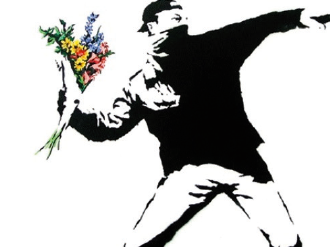Banksy: The Elusive Street Artist
Over the last decade, a new form of art has emerged: street art. ‘Graffiti’ you say? It is more than that. Graffiti is the pastime of many youngsters, but street art is something deeper, something that has meaning.
Without a doubt, the most famous of all street artists is Great Britain’s Banksy. A faceless artist, Banksy has been anonymously using the streets of England as his canvas since the ’90s. He hides behind a concealed identity, but he advocates a direct connection between an artist and people. “There’s a whole new audience out there, and it’s never been easier to sell one’s art,” Banksy maintained in an interview. “You don’t have to go to Art College. It’s not necessary to drag ’round a portfolio anymore. Don’t urge yourself to send your works to snooty galleries! All you need now is a few ideas. This is the first time the bourgeois world of art has belonged to the people. We must make it count,” he further added.
Many of Banksy’s pieces are humorous. He creates comedic scenarios. For instance, a maid lifts a wall to sweep dust underneath. But he also creates political or realistic pieces. He portrays homeless children on walls. Or he criticises violence. For example, one of his images shows a protester. The man is throwing something; but, Banksy changes the rock in his hand with flowers. Thus, he gives a strong message: Wage peace, not war. Throw flowers, not rocks.
Using the world as his canvas, Banksy defies legal and artistic rules and regulations. He displays his works in the most public and common of places: the streets. His messages, his style, his outlook on the world today, life, and art in itself makes him one of the great media artists of the modern age.

